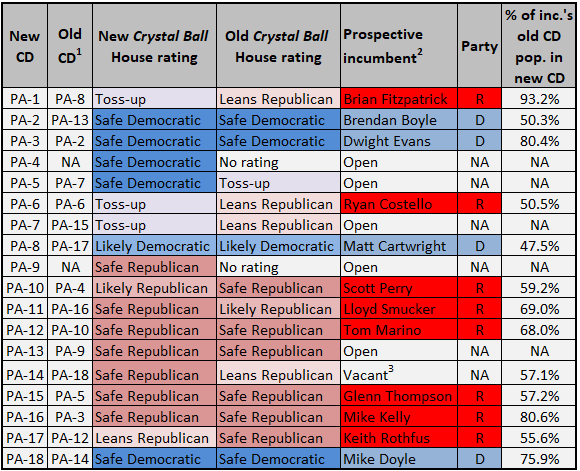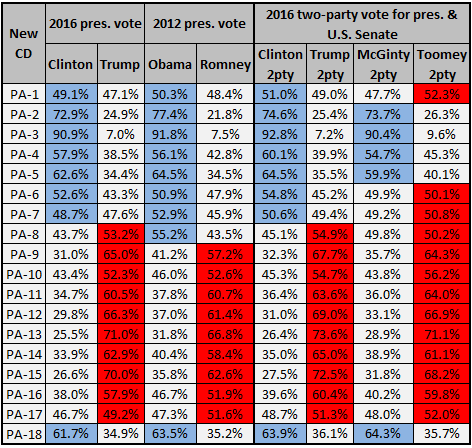Rating the New Pennsylvania House Map
A Commentary By Kyle Kondik and Geoffrey Skelley
Democrats now better-positioned to make gains
KEY POINTS FROM THIS ARTICLE
— Assuming that a new court-drawn U.S. House map stands, Democrats should be able to cut into the Keystone State’s currently 13-5 Republican House majority.
— The new map created one easy Democratic pickup, three Republican-held Toss-ups, and two other GOP seats that might be Democratic targets.
— With an eye on possibly winning a House majority in November, Democrats likely needed to net three or more seats from Pennsylvania before the remap, and the new map should make that task easier.
Breaking down the new Pennsylvania House map
A few weeks ago, we plotted a potential seat-by-seat Democratic path to a narrow House majority. That included a Democratic target of netting three additional seats from Pennsylvania, and the state’s new House map drawn by the Democratic-majority state Supreme Court should make it easier to meet or even exceed that benchmark.
The Keystone State stood out for having arguably the best Republican gerrymander in the country. The GOP-drawn map cemented a 13-5 Republican House majority, although that map hadn’t been tested in a pro-Democratic midterm environment, as 2018 should be to at least some degree. Democrats probably would have gained seats in Pennsylvania this November under the old map, but the new one improves their odds in several districts.
Pennsylvania Republicans are suing over the map, and there’s always a chance that the map may be overturned, even though legal experts like Rick Hasen of the University of California-Irvine consider that unlikely. In some cases, we also don’t know which members will run in which districts.
But despite the uncertainty, we’ve decided to issue new ratings of the new districts. We may have to quickly revise these new ratings as events dictate, or throw them out entirely if this new map is replaced by the old one or something else, but we wanted to lay down a marker about how this new map will alter the House calculus in the likely event that it stands.
First of all, the new district map completely changes the district numbers, with the 18 districts now numbered roughly in order from east to west. Only PA-6, currently held by Rep. Ryan Costello (R), has the same number as it had before, and even that district was changed substantially, becoming much more Democratic.
Table 1 shows our new ratings for the new districts as well as our best guess at which incumbents may be running where, while Table 2 shows the partisan details of the new districts that helped inform our new ratings.
Table 1: New Crystal Ball ratings and prospective incumbents in new Pennsylvania districts
Source: Population share for old districts compared with new districts from Daily Kos Elections
Notes: 1.) The old districts PA-1 and PA-11 are not included because there are no strong analogs on the new district map; moreover, the incumbents in those seats are not seeking reelection to the House. 2.) These prospective incumbents include those who had not already announced their retirement or candidacy for another office, and their seat placement corresponds to the new seat that contains the largest share of an incumbent’s old district. 3.) It is possible that the winner of the March special election for the old PA-18 will seek reelection in the new PA-14, so it is listed as vacant.
Table 2: 2012 and 2016 election data for new Pennsylvania congressional map
Sources: Election data from Brian Amos, Nate Cohn (New York Times)
Pennsylvania was already going to see a lot of change in its House delegation because five of the 18 current incumbents are retiring and a sixth, former Rep. Tim Murphy (R, PA-18 under the old map), resigned, necessitating a very competitive special election that will be decided on March 13.
Under the old map, PA-18 was a western Pennsylvania seat that Donald Trump won by about 20 points in the 2016 election. However, a tight race has emerged there between state Rep. Rick Saccone (R) and former federal prosecutor Conor Lamb (D). Polls show the race close but with Saccone leading, and we rate the special as Leans Republican.
However, the new map renumbers PA-18 as PA-14, and the district not only becomes even more Republican under the new map, but it also draws both Saccone and Lamb out of it. Under the new map, Saccone lives in a deeply Democratic Pittsburgh seat (the new PA-18 — we’re sorry this may be so confusing), while Lamb lives in a reconfigured PA-17, which is very competitive on paper.
If Saccone wins the special election for the old PA-18 in March, he likely can run as an incumbent in the new PA-14, which is considerably more Republican than the district he is running for now — Trump won the new seat by nearly 30 points. If Lamb wins, he may decide to run as an incumbent in the new PA-17, a district that Trump only barely won, setting up a potential member-vs.-member showdown against Rep. Keith Rothfus (R), whom we’re assuming will run for reelection in the reconfigured PA-17. Whereas Trump won Rothfus’ old seat by 21 points, he carried the new PA-17 by just 2.5. We’re starting the new PA-17 as Leans Republican, and it may go to Toss-up if Lamb or another credible Democrat runs there. Meanwhile, we’re starting PA-14 as Safe Republican, whether Saccone runs there as an incumbent or whether it is effectively an open seat. One wrinkle is that the new filing deadline for congressional races, March 20, is just a week after the March 13 special. So Lamb and/or Saccone may need to circulate petitions in new districts (congressional candidates must get 1,000 signatures) even before the special election in the seat they are currently trying to win. In terms of residency, Lamb already lives in the new PA-17 while Saccone would have to move if he wanted to establish residency in the new PA-14 (there is no legal requirement that someone has to live in a congressional district to run there, but politically it is helpful to have residency inside the district).
Staying in the Pittsburgh area, long-time Pittsburgh Rep. Mike Doyle (D) saw his district renumbered to PA-18, but it’s still a Safe Democratic seat. We’re also maintaining Safe Republican ratings for the new PA-13, PA-15, and PA-16. Of these three, PA-16 (which runs down the state’s western border with Ohio) could hypothetically be two-party competitive, but Rep. Mike Kelly (R) would start the 2018 cycle as a comfortable favorite in a seat Trump won by 20 points. Moving east, Republicans also maintain three other Safe Republican seats, PA-9, PA-11, and PA-12. Of the three, the new PA-11 is upgraded for Republicans. Under the old map, first-term Rep. Lloyd Smucker (R) represented historically Republican Lancaster County but also some more Democratic areas closer to Philadelphia. Now Lancaster County is joined with part of York County, its very Republican neighbor. So Smucker can run in a Safe Republican seat that Trump won by about 26 points.
Let’s move to Philadelphia. Under the old map, the Philadelphia area had three Safe Democratic seats; under the new map, it also has three safe seats — PA-2, PA-3, and PA-4 — though they aren’t a perfect analog to the old seats. One of PA-2 or PA-4 will be an open seat, depending on the choice of Rep. Brendan Boyle (D), whose current seat contains about half of each new district (Boyle appears likely to choose the bluer PA-2, which he also lives in). But now there is a fourth Safe Democratic seat, the new PA-5, centered on Delaware County in the Philadelphia suburbs. Retiring Rep. Pat Meehan (R) currently represents part of Delaware County, but this new PA-5 is a district that Hillary Clinton won by close to 30 points. PA-5 now represents the clearest Democratic pickup in the country, and we’re calling it Safe Democratic.
The aforementioned Costello (R) is a clear loser in this remap, because his Southeast Pennsylvania seat (PA-6 — remember, this is the same district number as before) got much more Democratic. The new PA-6 now contains all of Chester County, an affluent, highly educated suburban county that flipped from a tiny win by Mitt Romney to a nine-point Clinton win, as well as the part of Berks County that contains Reading, a small but very Democratic city. Clinton won the new district by nine points, though Sen. Pat Toomey (R) eked out a win there in 2016. Complicating matters for Costello is that his likely general election opponent, Air Force veteran Chrissy Houlahan (D), remains in the redrawn PA-6 and can continue running there.
Another southeastern district, PA-1, changed very little. It continues to be dominated by Bucks County, a swing county, but the remap flipped it from a district that Trump narrowly carried to one that Clinton narrowly won. Incumbent Rep. Brian Fitzpatrick (R) was likely in for a close race anyway, and his path got a tiny bit harder.
We’re going to call both PA-1 and PA-6 Toss-ups. Arguably, PA-1 (Fitzpatrick) should stay Leans Republican, and PA-6 (Costello) could be Leans Democratic, but we’ll just call both of them Toss-ups for now.
Joining those two in the Toss-up column is PA-7 in the Lehigh Valley, north of the Philadelphia area. This district features part of the old district currently represented by retiring Rep. Charlie Dent (R), and it became bluer, moving from a district that Trump won by about eight points to one Clinton carried by one.
Realistically, Democrats likely need to win two of these three Toss-up districts in southeastern Pennsylvania to be on course for winning the House.
Rep. Matt Cartwright (D) saw his Trumpy but ancestrally Democratic Scranton/Wilkes-Barre seat redrawn as PA-8 but largely unchanged at the presidential level: Trump won it by about 10 points under both the old and new maps. This district may be a Republican target this year (and almost certainly will be in the future), but we’re maintaining our Likely Democratic rating in the new PA-8 as a nod to the incumbent and the environment. Note that this district was considerably more Democratic in the 2016 U.S. Senate race than in the presidential. Self-funding businessman John Chrin (R), previously Cartwright’s likeliest GOP opponent, now lives in the open PA-7, so it’s unclear where he’ll run now.
Finally, Democrats may have a longshot target in PA-10, a new seat that Trump won by about nine points centered around the state capital, Harrisburg. Rep. Scott Perry (R) lives in the new district but could face a challenge in a more competitive district than his current seat, so we’ll start this district as Likely Republican.
Conclusion
Here’s the takeaway. First, remember that the Republicans presently control 13 of 18 Pennsylvania seats. Of the five current Democratic seats, four remain Safe Democratic and a fifth, the Trump-won northeast Pennsylvania seat held by Matt Cartwright (D), remains Likely Democratic.
Democrats have what appears to be a certain pickup in PA-5. Following that, they have three Toss-ups to target: PA-1, PA-6, and PA-7. As noted above, winning two of these three, along with holding all of their present seats and winning PA-5, would get Democrats to a net gain of three from Pennsylvania, which should be their goal. And they have a decent chance to exceed that if the national environment is clearly Democratic leaning. They could win all three Toss-ups, and they also have a new target in the western part of the state, PA-17, which could be a Toss-up eventually. The new Harrisburg-based PA-10 also could be competitive under the right conditions.
Like we said before, this is all subject to change. We don’t know what current incumbents will do and which new challengers will emerge. Republicans are also suing over the map. The PA-18 (old) special remains highly competitive, and it takes place only a week before the filing deadline for the redrawn seats.
So there’s a lot up in the air still, and we’ll be making adjustments to these ratings. But assuming the new map remains in place, it represents a boon to Democrats in what remains a coin flip national battle for control of the U.S. House of Representatives.
In a bit of housekeeping, the number of Clinton-won districts in Pennsylvania increases from six to eight under the new map. That now means there are 25 Clinton districts represented by Republicans in the House, up from 23 previously. So, hypothetically, Democrats could win an extremely narrow House majority by capturing every Clinton-won seat while retaining every district they already control (Democrats need 24 net seats to win the House, so one fewer than the total of Clinton seats). However, we do not think it’s realistic for them to win all of the Clinton-won seats because many of them have strong incumbents. So winning Trump-won seats from Republicans is necessary, too.
If the Democrats do win the House by just a few seats in November, it’s possible that the new Pennsylvania map will have made the difference. This actually would not be the first time that a new district map in Pennsylvania decided the House majority: prior to the 1888 election, Pennsylvania Republicans redrew the state’s district maps, and “without the strategic gerrymander in Pennsylvania, Republicans likely would have been in the minority,” writes Erik Engstrom in his excellent analysis of the history of gerrymandering, Partisan Gerrymandering and the Construction of American Democracy.
Again, it’s possible that Democrats could have made big gains in Pennsylvania under the old map: We already rated six GOP-held House districts there as competitive prior to the remap. But the new map does make the Democrats’ job easier by creating a safe Philadelphia-area pickup and making several other seats more Democratic.
Kyle Kondik is a Political Analyst at the Center for Politics at the University of Virginia.
Geoffrey Skelley is the Associate Editor at the Center for Politics at the University of Virginia.
See Other Political Commentary by Kyle Kondik.
See Other Political Commentary by Geoffrey Skelley
See Other Political Commentary
Rasmussen Reports is a media company specializing in the collection, publication and distribution of public opinion information.
We conduct public opinion polls on a variety of topics to inform our audience on events in the news and other topics of interest. To ensure editorial control and independence, we pay for the polls ourselves and generate revenue through the sale of subscriptions, sponsorships, and advertising. Nightly polling on politics, business and lifestyle topics provides the content to update the Rasmussen Reports web site many times each day. If it's in the news, it's in our polls. Additionally, the data drives a daily update newsletter and various media outlets across the country.
Some information, including the Rasmussen Reports daily Presidential Tracking Poll and commentaries are available for free to the general public. Subscriptions are available for $4.95 a month or 34.95 a year that provide subscribers with exclusive access to more than 20 stories per week on upcoming elections, consumer confidence, and issues that affect us all. For those who are really into the numbers, Platinum Members can review demographic crosstabs and a full history of our data.
To learn more about our methodology, click here.





